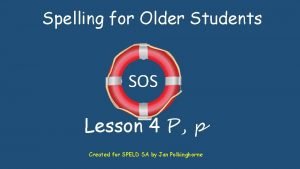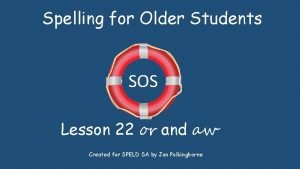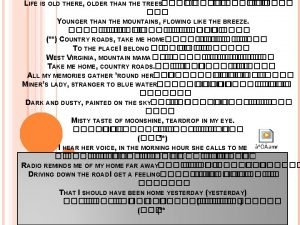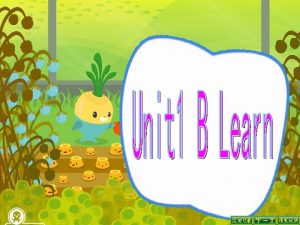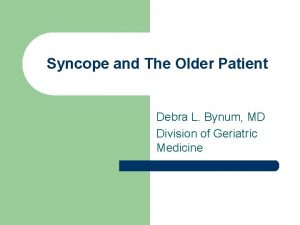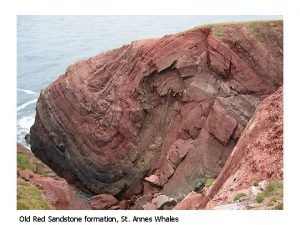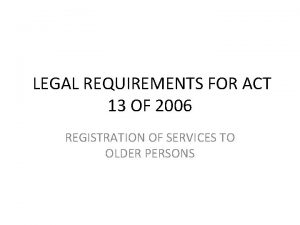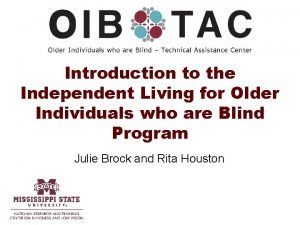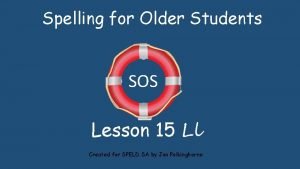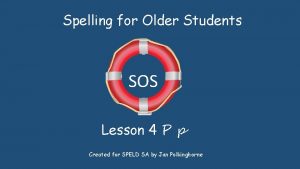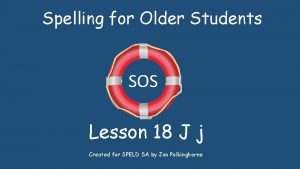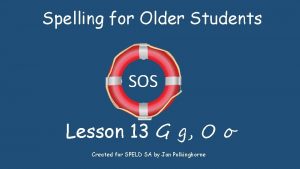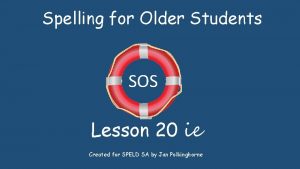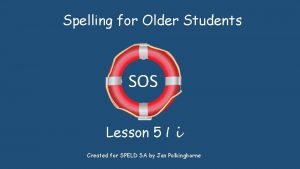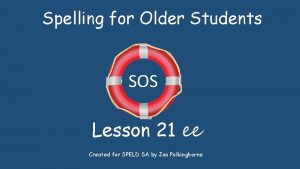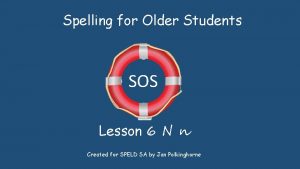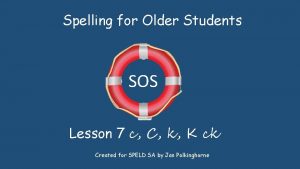Spelling for Older Students SOS Lesson 31 ou














- Slides: 14

Spelling for Older Students SOS Lesson 31 ou and ow Created for SPELD SA by Jan Polkinghorne

Sounds in a word Say the names of these pictures. Use your fingers to count how many sounds in each word. NOTE that is sounds not letters. h-e-l-i-c-o-p-t-er 9 r-o-ck-e-t 5 Click for answers

Rhyming words. Find words to rhyme with each of these. farm calm balm psalm palm qualm torch porch scorch

What is the same about all these pictures? Say the words aloud. They all have ou sound in them: trousers, mouse, cloud, frown, mountain, Click the box for the answer. owl, blouse, crown, crouch, fountain, howl, house, crowd, powder.

ou and ow vowel sounds. All letters in our alphabet belong to one of two groups A diphthong is a special kind of vowel sound. Most vowel sounds in English are made with the mouth in one position and with one pure sound- these are called monophthongs (mono =“one” and phthong =“sound”). A diphthong is a vowel sound formed by the combination of two vowel sounds. A diphthong begins as one vowel sound and moves toward another, such as the vowel sounds in coin or loud. When to use ou and when to use ow. • Use ow at the end of words or syllables. borrow, throw, crow, flow-er, tow-el. • Middle of word can be ‘ou’ or ‘ow’ but ‘ou’ much more common. • Use ow before n and l. owl, fowl, down, frown, crown. • Use ou before nd. Sound, found, mound, pound Sort all of your bottle top letters into vowels and consonants. We need to know whether a letter is a vowel or consonant to help us apply spelling rules.

Read the words in both lists. Words with * are homophones. Revise the meaning of the term homophone. Find the pairs of homophones and discuss the meanings of each spelling. Can you find any words which are exceptions to the generalisations on the previous page?

Complete the requirements for the next screen before proceeding. See Instructions. Use your ears and listen carefully.

Emily has gone to stay at her grandmother’s house. Emily’s grandmother does a lot of sewing. Emily asks if she can do some sewing, too. Her grandmother gets out a piece of cloth from her sewing basket. Emily has found a reel of black cotton and her grandmother helps her to thread the needle. She sits down on the couch and does a few stitches. Then, as she pushes the needle through, she pricks her thumb. She frowns and shouts “ou! That hurt!” “You must be careful, Emily, ” says her grandmother. By the end of her visit, Emily has done a lot of sewing. She is much better at it now, and she has made a little mat as a present for her parents. She has embroidered a brown owl on it.

How to write the letters ‘ou and ow’ Linked script is far better to write than printing. It is faster, easier, more comfortable to write for long periods and your brain learns the words better if they are linked. ou ow A brown house

Put ou or ow in the space. Write the word. Say the word. -t f-nd m-nt gr-nd -l sh-er s-th fl-er sh-t br-n m-th h-se r-nd t-n sc-t m-se out, owl, shout, round found, shower, brown, town mount, south, mouth, scout ground, flower, house, mouse Click for answers

How many words can you make using these letters? l, sh, ou, p, n, t, e, ow, f You may use a letter as many times as you like in a word. What is the longest word you can make? You might be able to apply the doubling rule if you think of longer words.

Tricky Words – non phonetic made Click to reveal the word their Click to reveal the word Discuss the difference between there and their.

Revision. Time to revise Set 31 Tricky Words

Instructions. • Slide 2 counting sounds in a word. The answer is frequently not the same as the number of letters in the word. • Slide 3 Rhyming words • Slide 4 Hearing ou sound. • Slide 5– knowing vowels and consonants is vital for learning spelling rules. Multisensory learning (feeling the formation of a sound) is useful for many students. Rule 1: If the short vowel pronunciation doesn’t work to make a word try the long vowel. What is a diphthong? Generalisations of when to use ou and when to use ow for ou. • Slide 6 - Reading ou and ow words. Finding the homophones and discussing their meanings. • Slide 7 and 8. Read the story for ou aloud. Ask each student to keep a tally of how many ou sounds they hear in the story. Compare results. They need to use ears not eyes. Hand each student a copy of the story. Read it aloud again and have students mark each ou sound as they go. • Slide 9–writing ou/ow and linking. Handwriting I have used Sego Script because it is freely available on most computers. Research is now showing that linked script is more ergonomic and helps with retention of spelling. Many prospective employers are expecting job applications to be handwritten and many exams have to be handwritten. It is still a necessary skill. • Slide 10 - Making words by inserting ow or ou. • Slides 11 How many words can students make? • Slide 12 and 13 Tricky words. These words are high frequency, often non phonetic and have to be learnt by rote for both spelling and reading. Spell with alphabet names. Do not sound.
 Sos spelling for older students
Sos spelling for older students Sos spelling for older students
Sos spelling for older students Life is older older than the trees
Life is older older than the trees What image did rizal carved on a piece of batikuling?
What image did rizal carved on a piece of batikuling? Spelling lesson 2: content words
Spelling lesson 2: content words Web accessibility for older users
Web accessibility for older users Tall strong younger sister
Tall strong younger sister Syncope in the older patient is
Syncope in the older patient is Synformal anticline
Synformal anticline Mental health and older adults
Mental health and older adults Dq98 assessment form
Dq98 assessment form Late adulthood mental development
Late adulthood mental development Older individuals who are blind program
Older individuals who are blind program Mental health and older adults
Mental health and older adults Altered cognition in older adults is commonly attributed to
Altered cognition in older adults is commonly attributed to
